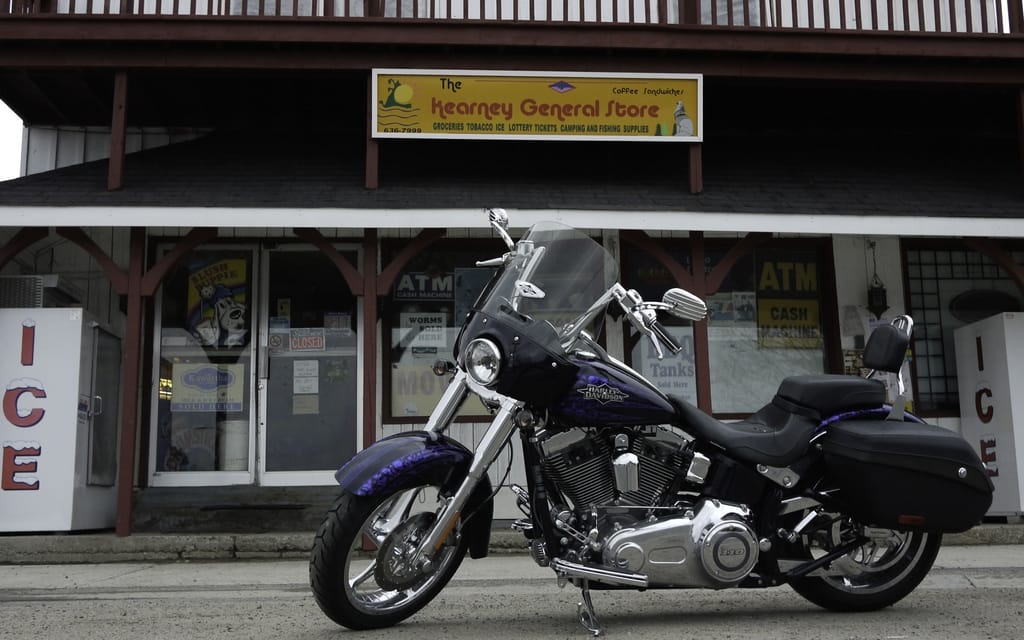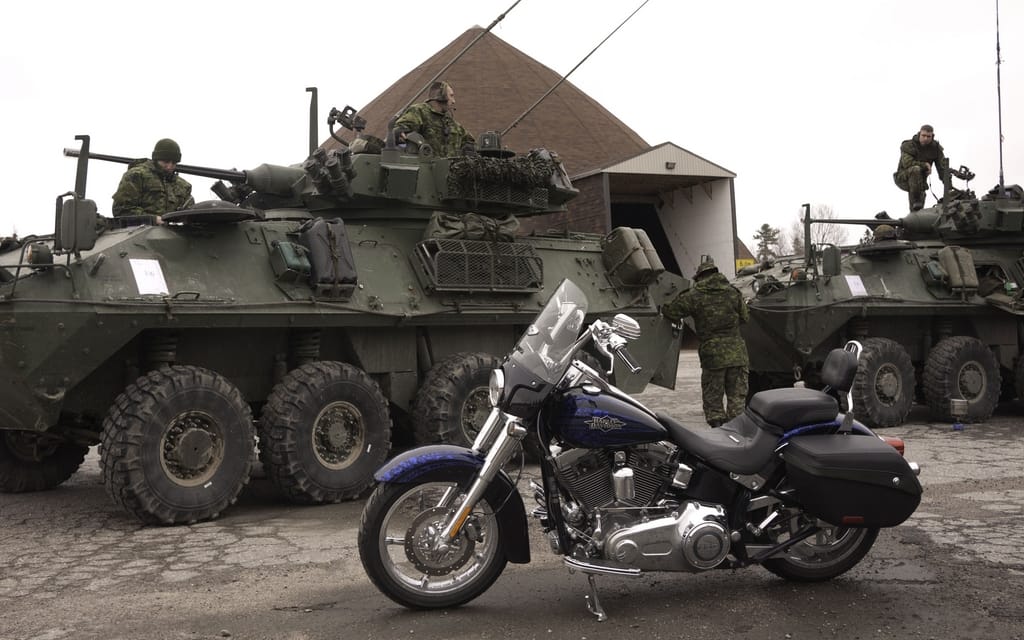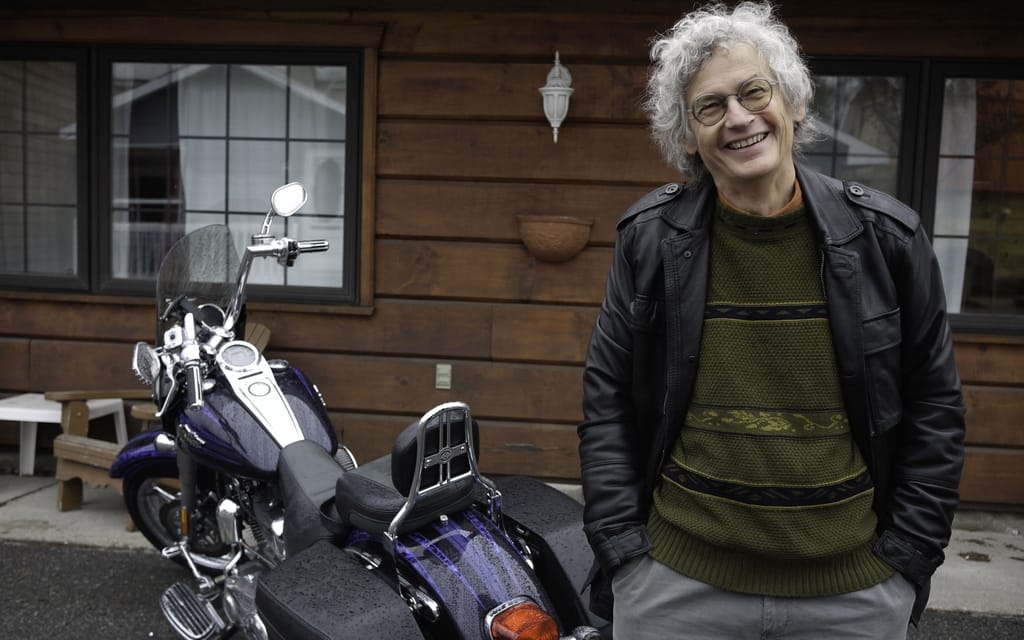Harley’s quick-change artist looks good either way. For a price, can have your hot dog and eat it too
The turtle looked about as dead as a turtle can get. It lay on its back in the road, doubtless the victim of some driver who had just destroyed his own karma. The Harley rumbled and groaned and the turtle disappeared in the past.
But not thoughts of the turtle, damnit. First, the advertising jingle: “Oh, I love turtles.” And then the song: “If I should call you up, invest a dime …” (You kids, just google it.)
About two km down the road, a driveway opened up on the left, enabling an easy U-turn. Back, slowly, for the road was crusted with sand from one shoulderless side to the other. And twisty: this road was so filled up with turns, the faster you went, the longer it took you to get there.
The turtle, as it happened, was neither dead nor overturned. It lay on its belly, hardly moving, but a tap of a gloved finger to its sharply pointed snout caused it to retract its head, just a bit. It smelled bad and didn’t react to being picked up, nor to being put down in the shady underbrush off the road, where it would likely die. The Harley boomed and snorted, and the road continued to twist and writhe.
It happens, sometimes, that you enjoy a positive engagement with a road in a way that would be impossible with the correct motorcycle. This road, Hwy 13 in Ontario’s Muskoka region, cries out for a motorcycle with a short wheelbase and great brakes. Everything, in short, that the Harley-Davidson CVO Softail Convertible is not. The CVO has 64 inches of wheelbase and a front brake that feels soft even with a full-fisted squeeze on the lever. The CVO also has anti-skid braking, though you can’t tell it from looking at the wheels, and for the front wheel, at least, it seems redundant, though we did manage to activate the rear ABS.
By early May, the snow is gone from this Muskoka road but the sand is spread like jam on a pretzel. Ride a streetbike at more than 50 km/h and you could miss one of the narrow clear strips, and then off you go. You’ll sleep with the turtles.
Here, the CVO (Custom Vehicle Operations) Convertible is a cool drawl on a wahm sunny mawnin. You can just about count the engine revolutions on your fingers at idle, and well below its 2,750 rpm torque peak the 110 cubic inch fuel-injected V-twin pulls smoothly. It runs so easily down in the low rpm ranges that a gnarly, slippery road like 13 seems a proper environment for it.
By mid-July, the CVO would be struggling and tearing its footboards apart, for with a 26-degree maximum lean angle, it grinds the rear edge of a footboard at moderate cornering speeds, and will shriek all the way around a highway onramp if ridden with any enthusiasm. But in these conditions the CVO trolls easily between sandbanks and feels good doing it; the sound from a pair of chromed shorty exhausts is a pleasing, slightly muted roar, the high and wide handlebar allows good leverage so the handling feels light, and the engine is completely tractable. A full-throttle in sixth gear from 1,000 rpm, on another road, got the engine barking in protest, but it pulled steadily and very quickly found its comfort level. When taking off from a stop, the CVO’s abundant torque makes it feel like a dog trying to break its leash; it’s eager.
Eager, maybe, but the 110 cubic inch (1800 cc), counter-balanced and solidly mounted engine makes only moderate horsepower (we’ve seen figures in the high 70s), and runs hard into a rev limiter at an indicated 5,200 rpm. There’s no need to rev it that high, though, since short-shifting at 4,000 rpm will produce acceleration that gets the motorcycle up to illegal highway speeds very quickly. Sixth gear is not an overdrive, and will drop revs by about 500 at 110 km/h per hour, from 2,500 rpm in fifth to 2,000. That’s a nice, loping speed for a highway run, and leaves plenty of power available for a pass without downshifting.
We had time to test the CVO’s passing abilities on this ride, from Toronto to North Bay on a windy, overcast day. Former CC writer Max Burns lives near that city of 50,000, which is about four hours north of Toronto. It’s been too long since we’ve seen him and we wondered, what the hell is Max up to? Since there was a CVO Convertible in the Cycle Canada paddock, finding out seemed a worthwhile venture.
It wasn’t long before concerns about the CVO overshadowed any thoughts of former contributors. Before we left Toronto, the four-way flashers started blinking, and finding the means to turn them off required a careful examination of switchgear — which is actually quite logical and very effective. Near the right handgrip there are four switches: one is a regular Start button; another is a Run/Off button — necessary because there is no keyed ignition switch, only a requirement that the transponder key fob is close to the bike — and below those two are a switch for the right turn signal, and a Cruise Control button. We found a small Four-Way Flasher symbol on the top half of the Start button. It had evidently been smacked in the process of turning off the bike.
Back to our coffee, which was still hot.
Max Burns is alive and well and working in a dress shop.
By alive and well, we mean there is no change in his condition. That’s good. And by working in a dress shop, we don’t mean he’s wearing the damn things. In fact, he isn’t even sewing them. He’s converting a house that formerly served as a number of offices for lawyers into a working space for a clothing alterations business, which his wife Jackie runs with a handful of employees, and a living space and workshop area. It’s a house with many rooms and Max seems to be good at what he’s doing, though he professes to be worn out from all the labour. It does appear, however, to be a labour of love, and we were glad to discover that life is still friendly to our old friend Max Burns.
After breakfast and a brief tour of North Bay, we headed south on the CVO Convertible. We were tempted to test its convertibility in North Bay, but didn’t want to be stranded far from home with a windscreen that we could not wrestle back into place, and the operation looked tricky.
Overheard in the pub: “I’ve got multiple personality disorder. But it’s okay — I’ve got multiple body disorder, too. See that guy over there? That’s me.”
Calling the CVO Convertible “schizophrenic” would be wrong, because this motorcycle is in fact firmly anchored to reality, and the word shouldn’t be used to suggest two personalities, anyway; it doesn’t mean that. But Harley-Davidson does want you to think of this bike as a vehicle with two distinct characters and two bodies: it’s a cruiser, and it’s a touring bike. On Saturday nights, you can remove the leather-look saddlebags, the sissy bar, and the windscreen, and you’re left with a straight-ass cruiser. What’s more, you can do it all without tools. On Sunday morning, you can slap it all back on and get out of town. Maybe go to Hamilton.
Removing the saddlebags is accomplished by opening each bag, rotating an interior switch that gets a locking bar out of the way, and pulling the bag back and off. It’s simple, once you’ve done it, and reinstalling is not very tiresome, though you have to line up a stabilizing rod and the bag’s two slots with some rubber grommets. Removing the sissy bar involves pressing a spring-loaded latch and pulling. Simple. Removing the windscreen, however, turned out to be more of a chore. The windscreen is held on by a double pair of hooks that slide into rubber grommets, and at first it was reluctant to come loose. We applied some force, and off it came, sliding up and away from the bike. Thereafter, with the addition of a dab of silicone to help move things, it came off easily.
One feature of the CVO is a Garmin GPS unit, which is stuck to the windscreen, and so a wire must be detached before the windscreen can be separated from the bike. It’s a simple procedure and the components seem well designed. Though the windscreen is not clasped by much, one tester commented that you’d have to accelerate really hard in reverse for it to fly loose. There is no reverse gear on the CVO, though we don’t think that’s why.
In any case, we didn’t test the windshield removal process in North Bay, but waited until we were back near the office. Then, with two people working on it, we removed everything, pulled out a timer, and clicked Start. Two minutes and two seconds later, the windscreen, saddlebags, and sissy bar were back in place.
But that was back in T.O. Before that, as we headed south from North Bay, we discovered another feature of the CVO’s switchgear that caused some concern. Occasionally, when using cruise control and then returning a rested right hand to the throttle, we managed to kill the engine. That caused a moment’s confusion: had we just deactivated the cruise control? Because there’s no keyed ignition, the kill switch is part of the Run switch: down for running, up for not. Accidentally jabbing the Off switch when returning a hand to the grip was easy enough to do that it happened more than once.
Still, the switchgear is nicely arranged, and works remarkably well. The Cruise Control switch is at the bottom of the switch block, and functions smoothly. Depress for on, press right to accelerate and left to slow down. The cruise control function itself is extremely smooth and was hardly noticeable, even on hills.
The seat, which draws into a point at the front, was noticeable, though not until a couple of hundred kilometres had been run up. It’s well-shaped, and its low height (which becomes an inch or so lower when the bike is sat upon) allows easy reach to the ground even for short people. However, after some time in the saddle, a rider would feel some pain, not in the back or the fat part of the buttocks, but farther forward. It was noticeable, though not severe.
Controls on the CVO are nice, thick metal pieces. The mirrors are attractive and present a good view to the rear. The clutch and brake lever are large and work best with more than two fingers applied. With just two fingers drawing the clutch lever in, the bike would not shift gears; the lever must be pulled back nearly as far as it will go before the clutch disengages enough to shift. The shift lever, also, takes some force to move, and finding neutral was difficult at stoplights; any force strong enough to move the lever was strong enough to push it right past neutral. The footboards were a little uncomfortable, too; they tilt the legs out slightly and they vibrate with the road, which tends to slide the feet off the boards; some tension was needed to keep legs and feet in place.
The CVO Convertible is a partially successful attempt at making two motorcycles out of one body. Where it falls short — at the clutch lever, at the front brake, at the seat — it’s not a result of building a bike that changes to suit the rider’s whim. Where it succeeds, the wonderful torque of the large V-twin, the large and waterproof saddlebags, the windscreen that lets only slight turbulence get at the rider’s head, the well-made switches and, we must admit, some glorious paint, it’s typically Harley-Davidson.
But never mind the hype; this is one motorcycle, not two. If the thought of removable components turns your crank, we don’t suggest buying this bike. But if a big, torquey engine, handling that makes its 357 kg mass feel lighter, a raw, throaty, but not annoying exhaust note, a very low seat height, and cruise control and included GPS make you feel all warm and mingly, and you have 33 grand to spare, and you think a change is as good as a rest — maybe this is your next motorcycle.
South of North Bay, we encountered some Canadian soldiers on large-wheeled vehicles parked just off the road, and couldn’t resist stopping for a photo. The soldiers were on practice manoeuvres and the vehicles were LAVs and Coyotes, lightly armoured vehicles with wicked looking 25 mm cannons. The soldiers were talking on headphones, clambering around their green fighting vehicles, and practising their craft. They stopped as the Harley pulled up close, and one or two got camera phones out to take pictures.
They liked the CVO. We each made photographs of the others’ vehicle, and then one of the soldiers started hollering, “Who wants a hot dog?” You could smell them, roasting somewhere behind a Coyote. “The infantry gets mad at us armoured guys,” said one of the soldiers, “because we get to carry stuff, like barbecues.”
You just never can tell about a thing, that’s all. You think it’s capable of pumping out 400 rounds a minute and blowing the shit out of anything that gets in its way, and then you find out it’s carrying a barbecue and a box of hot dogs. It’s the nature of the beast, maybe, this ability to be one thing, and then another thing, without ever really changing its essential self. And the smell in the air, well that was simply delicious.








